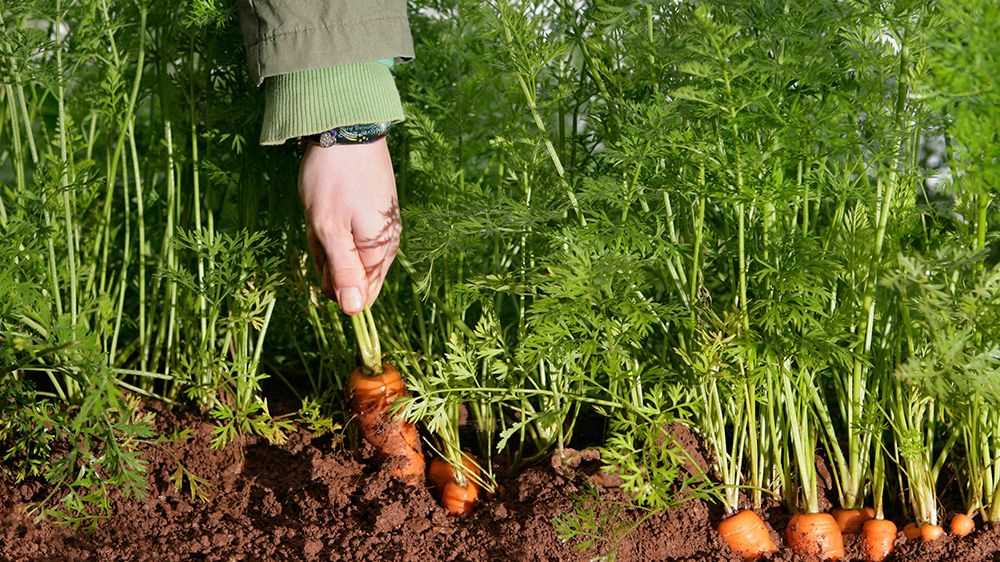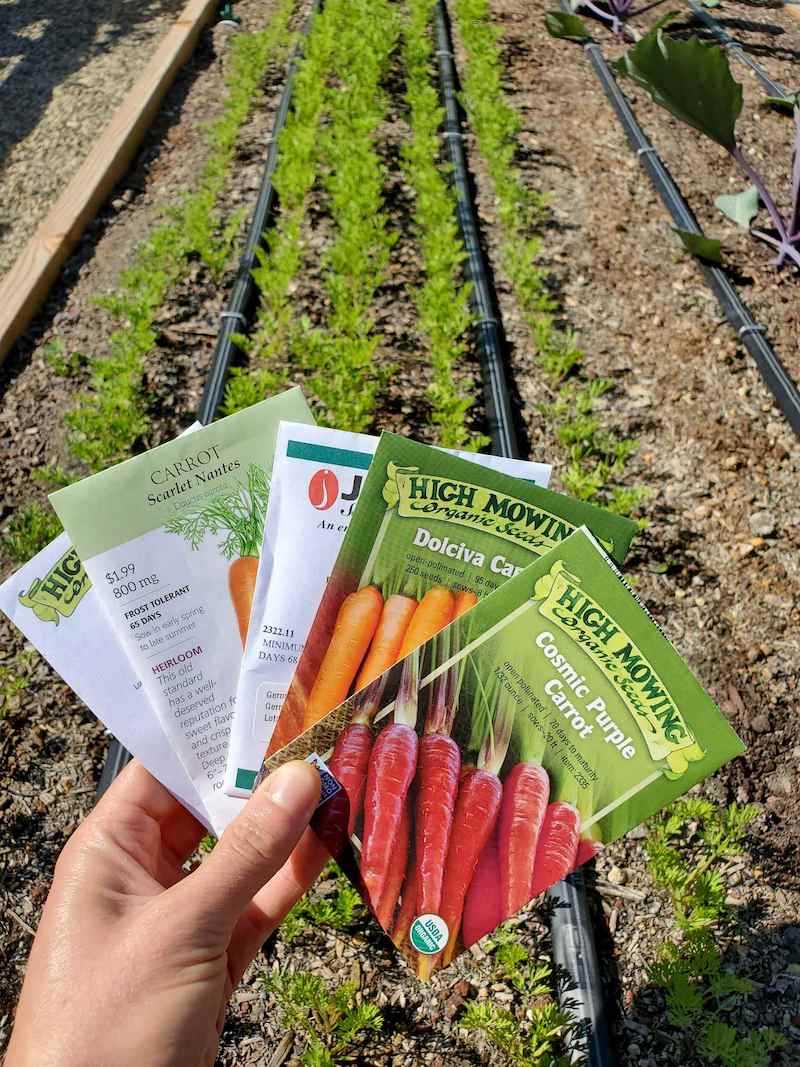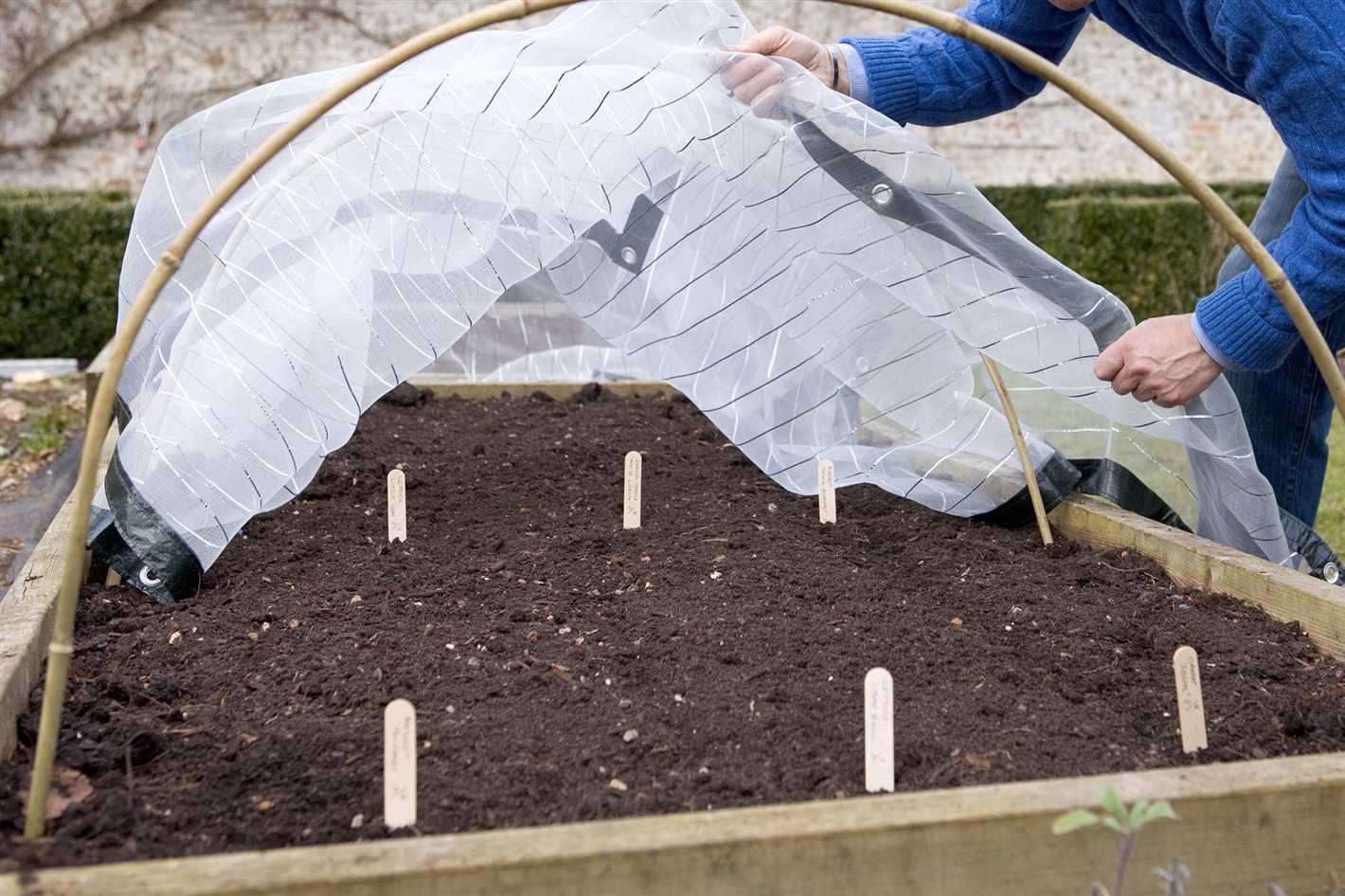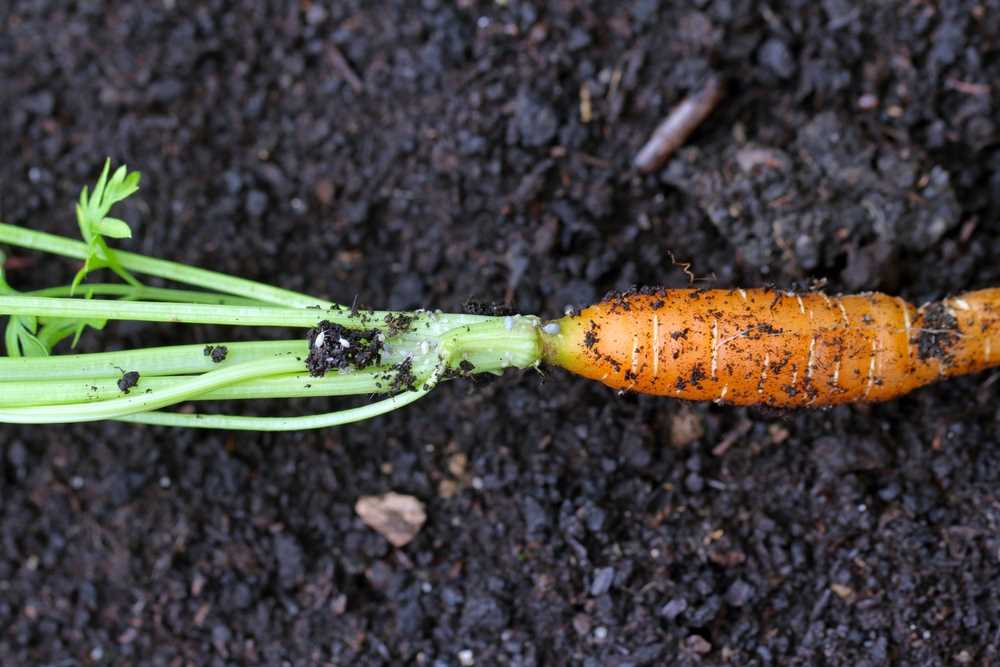- Evaluating Different Carrot Varieties
- Taste
- Size and Shape
- Disease Resistance
- Finding the Ideal Variety for Your Climate
- 1. Cold Climate
- 2. Warm Climate
- 3. Intermediate Climate
- 4. Water Availability
- 5. Disease Resistance
- 6. Taste and Texture
- Considering the Desired Carrot Characteristics
- Exploring Different Colors and Flavors
- Orange Carrots
- Purple Carrots
- Yellow Carrots
- White Carrots
- Preparing the Bed for Autumn Sowing
- 1. Choose the Right Location
- 2. Clear the Area
- 3. Loosen the Soil
- 4. Amend the Soil
- 5. Level and Rake the Bed
- 6. Apply Fertilizer
- 7. Water the Bed
- Clearing the Bed and Removing Weeds
- Improving Soil Quality with Organic Amendments
- Types of Organic Amendments
- Benefits of Organic Amendments
- Application of Organic Amendments
- Creating a Loose and Well-Drained Soil
- Preparing the Soil
- Improving Drainage
- Using Raised Beds or Raised Rows
- Conclusion
- Protecting the Bed from Pests and Diseases
- 1. Crop rotation
- 2. Companion planting
- 3. Mulching
- 4. Regular inspection
- 5. Organic pest control
- “Question-Answer”
- How do I choose the right carrot variety for autumn sowing?
- What are some recommended carrot varieties for autumn sowing?
- How should I prepare the bed for autumn sowing?
- Is it necessary to test the soil before sowing carrots in autumn?
- Can I sow carrots directly in the ground in autumn, or should I start them indoors?
- “Video” Trick to germinate CARROT seeds FASTER and more EVENLY; Fall/Winter Planting #GardenHacksThatWork
Autumn is the perfect time to sow carrots, as the cooler temperatures and moist soil create the ideal conditions for germination and growth. However, in order to ensure a successful harvest, it is important to choose the right carrot variety and prepare the bed properly.
When selecting a carrot variety, it is essential to consider factors such as flavor, size, and growth habit. Some varieties are known for their sweet and tender taste, while others are prized for their large size. Additionally, certain varieties may be more suitable for growing in containers or raised beds, while others thrive in traditional garden beds.
Another crucial factor in successful autumn sowing is bed preparation. Carrots prefer loose, well-draining soil that is free from rocks and debris. Before sowing, the bed should be cleared of weeds and any large clumps of soil should be broken up. Adding organic matter such as compost or well-rotted manure can also improve soil fertility and structure.
By carefully selecting the right carrot variety and preparing the bed properly, gardeners can set themselves up for a successful autumn sowing. With the right conditions in place, these vibrant root vegetables will soon be ready to harvest and enjoy in a variety of delicious recipes.
Evaluating Different Carrot Varieties
When choosing a carrot variety for your autumn sowing, it is important to consider several factors such as taste, size, shape, and disease resistance. Different carrot varieties have different characteristics, and evaluating them can help you make an informed decision.
Taste
- Sweetness: Some carrot varieties are known for their sweetness, while others have a more mild or earthy taste. Consider your personal preference when it comes to the taste of carrots.
- Crunchiness: Carrot varieties can also vary in their crunchiness. Some are crisp and crunchy, while others are more tender. Think about the texture you prefer in a carrot.
Size and Shape
Carrots come in different sizes and shapes, and choosing the right variety depends on your culinary needs and preferences.
- Standard: Standard carrot varieties are typically long and cylindrical in shape.
- Nantes: Nantes varieties are shorter and thicker compared to standard types. They have a blunt tip and are often considered easier to grow.
- Chantenay: Chantenay carrots are shorter and broader, with a conical shape. They are known for their crispness and sweet flavor.
Disease Resistance
Some carrot varieties are more resistant to certain diseases, which can help ensure a successful harvest.
| Variety | Disease Resistance |
|---|---|
| Carrot A | Resistant to Carrot Fly |
| Carrot B | Resistant to Powdery Mildew |
| Carrot C | Resistant to Root Knot Nematodes |
Evaluating different carrot varieties based on taste, size and shape, and disease resistance will help you select the right variety for your autumn sowing. Make sure to consider these factors and choose a variety that suits your preferences and gardening needs.
Finding the Ideal Variety for Your Climate
Choosing the right carrot variety for your climate is essential for successful autumn sowing. Carrots are categorized into different types, each with its own unique characteristics and requirements. Here are some considerations to keep in mind when selecting a carrot variety for your specific climate:
1. Cold Climate
If you live in a cold climate region where the temperatures can drop significantly, it is important to choose a carrot variety that is adapted to cold conditions. Look for varieties that have a shorter maturity time and are frost-tolerant. These varieties can withstand lower temperatures and have a higher chance of surviving the winter.
2. Warm Climate
In warmer climates, carrots may not perform well due to high temperatures and long growing seasons. It is advisable to choose heat-tolerant varieties that can withstand the heat and take longer to bolt. Look for varieties that are specifically bred for warm climates to ensure a successful crop.
3. Intermediate Climate
If you live in an intermediate climate where the temperatures are neither extremely cold nor excessively hot, you have a wider range of carrot varieties to choose from. Look for varieties that have a balanced growth rate and can tolerate a moderate range of temperatures. These varieties are generally more versatile and can adapt well to different climate conditions.
4. Water Availability
Consider the water availability in your region when selecting a carrot variety. Some varieties require more water than others, so choose accordingly based on your access to water sources. In drier regions, drought-tolerant varieties can be a better choice, while in areas with ample water supply, you can opt for varieties that require regular watering.
5. Disease Resistance
Check if the carrot variety you are considering has any disease resistance traits. Some varieties are more resistant to common carrot diseases, such as cavity spot, powdery mildew, and carrot rust fly. Choosing disease-resistant varieties can help in preventing crop losses and promoting healthy growth.
6. Taste and Texture
Lastly, consider the taste and texture of the carrot variety. Some varieties may have a sweeter flavor while others are more crunchy or tender. Choose varieties that suit your taste preferences and culinary needs.
By considering these factors, you can find the ideal carrot variety that is well-suited to your specific climate conditions. Remember to read seed catalogs and consult local experts for further guidance on the best carrot varieties for your region.
Considering the Desired Carrot Characteristics
- To choose the right carrot variety for your garden, you need to consider certain desired characteristics:
- Size: Carrots come in different sizes, ranging from small to large. Consider the size that best fits your needs, whether you prefer baby carrots or larger ones.
- Shape: Carrots can have various shapes, including cylindrical, conical, or round. Select the shape that suits your culinary preferences or the dish you plan to prepare.
- Color: Carrots come in different colors, such as orange, red, yellow, purple, and white. Choose the color that matches your aesthetic preferences or the color scheme of your garden.
- Texture: Carrots can have different textures, ranging from crisp to tender. Consider the texture you prefer for your culinary creations or how you plan to use the carrots.
- Flavor: Carrots can have varying levels of sweetness and flavor intensity. Consider the flavor profile you desire for your recipes or personal taste preferences.
- Growth Habit: Some carrot varieties may have different growth habits, such as the length of the root or the foliage. Consider the growth habit that suits your gardening preferences and available space.
- Storage: Certain carrot varieties have better storage capabilities than others. If you intend to store your carrots for a longer period, select a variety known for its good storage attributes.
- It’s important to note that each carrot variety may have different combinations of these characteristics, so it’s essential to consider your preferences and needs when making your selection.
Exploring Different Colors and Flavors
Carrots come in a variety of colors and flavors, offering a range of options for gardeners and chefs. While most people are familiar with the traditional orange carrot, there are also purple, yellow, and white varieties available. Each color has its own unique flavor profile and nutritional benefits.
Orange Carrots

Orange carrots are the most common and widely available variety. They are known for their sweet, slightly earthy flavor. Orange carrots are rich in beta-carotene, which is converted into vitamin A in the body. This makes them excellent for promoting good vision and a healthy immune system.
Purple Carrots
Purple carrots have a vibrant color and a slightly sweeter taste compared to orange carrots. The purple hue comes from the presence of anthocyanins, which are powerful antioxidants that have been linked to various health benefits, such as reducing the risk of heart disease and certain types of cancer.
Yellow Carrots

Yellow carrots have a milder flavor compared to orange and purple varieties. They are slightly sweet and have a crisp texture. Yellow carrots are rich in carotenoids, which are antioxidants that can help protect against age-related macular degeneration and promote healthy skin.
White Carrots
White carrots have a subtle, almost nutty flavor. They are slightly less sweet compared to orange and purple varieties. White carrots contain a variety of nutrients, including potassium, dietary fiber, and vitamin C. They are also low in calories, making them a great option for those on a diet.
When choosing carrot varieties for your garden, consider mixing different colors to create a visually appealing and nutritious harvest. Each color brings its own unique flavor and health benefits to the table. Experiment with different varieties and enjoy the diverse flavors nature has to offer!
Preparing the Bed for Autumn Sowing
Preparing the bed is a crucial step in ensuring successful autumn sowing of carrots. Proper preparation of the bed will provide the ideal growing conditions for your carrot seeds and promote healthy plant development.
1. Choose the Right Location
When selecting the location for your carrot bed, choose a spot that receives full sun for most of the day. Carrots require at least 6 hours of direct sunlight to thrive. Ensure the area has well-drained soil to prevent waterlogged conditions, which can lead to rotting of the carrot roots.
2. Clear the Area
Before preparing the bed, remove any weeds, rocks, or debris from the area. Weeds can compete with the carrot plants for nutrients and water, while rocks and debris can hinder root development and cause misshapen carrots.
3. Loosen the Soil

Using a garden fork or tiller, loosen the soil to a depth of at least 8 inches. Break up any large clumps and remove any hard soil or stones. Carrots prefer loose, well-drained soil that allows their roots to grow straight and long.
4. Amend the Soil
Carrots thrive in soil that is rich in organic matter. Incorporate compost, well-rotted manure, or peat moss into the top few inches of the soil. This will improve soil fertility, drainage, and moisture retention.
5. Level and Rake the Bed

After amending the soil, use a rake to level the bed. Smooth out any bumps or uneven spots, ensuring a flat and even surface for sowing the carrot seeds.
6. Apply Fertilizer
Apply a balanced fertilizer, such as a 10-10-10, according to the package instructions. Gently rake the fertilizer into the soil, making sure it is evenly distributed. This will provide the essential nutrients for the carrot plants’ growth.
7. Water the Bed
Before sowing the seeds, thoroughly water the bed. Moistening the soil will help with seed germination and encourage the carrots to establish strong root systems.
Following these steps will ensure that your carrot bed is well-prepared for autumn sowing. With proper bed preparation, you are on your way to growing healthy and delicious carrots!
Clearing the Bed and Removing Weeds
Before sowing your carrot seeds, it is important to clear the bed and remove any weeds. Weeds compete with the carrots for nutrients, water, and sunlight, and can affect the growth and yield of your crop.
To clear the bed, start by removing any large rocks, sticks, or other debris that may interfere with the growth of your carrots. Use a rake or a garden fork to loosen the soil and remove any clumps. This will create a smooth and level surface for sowing your seeds.
Next, identify and remove any weeds that may be present in the bed. Weeds can be manually pulled out by hand or using a hand tool such as a garden trowel or hoe. Be sure to remove the entire weed, including the roots, to prevent regrowth.
It is best to remove weeds before they have a chance to flower and produce seeds, as this will help prevent the spread of weeds in your garden. Additionally, removing weeds will also help improve air circulation and reduce the risk of disease in your carrot crop.
After clearing the bed and removing the weeds, it is a good practice to add organic matter such as compost or well-rotted manure to the soil. This will help improve the soil structure, fertility, and moisture retention, creating a favorable environment for your carrot plants to thrive.
Remember to regularly monitor your carrot bed for any new weed growth and promptly remove them to ensure the best possible growing conditions for your carrots.
Improving Soil Quality with Organic Amendments
Soil is a crucial component for successful gardening, and its quality directly affects the growth and health of plants. One effective way to improve soil quality is by using organic amendments. These natural materials can enhance the structure, fertility, and nutrient content of the soil, resulting in healthier plants and higher yields.
Types of Organic Amendments
There are various types of organic amendments that can be used to improve soil quality:
- Compost: Compost is a mixture of decomposed organic matter such as plant material, animal manure, and kitchen scraps. It enriches the soil with essential nutrients, improves water retention, and enhances soil structure.
- Manure: Animal manure, such as cow, horse, or chicken manure, is rich in nutrients and organic matter. It is an excellent fertilizer that improves soil fertility and promotes healthy plant growth.
- Cover crops: Cover crops, such as legumes or grasses, are grown specifically to protect and improve the soil. They add organic matter, fix nitrogen from the air, and prevent erosion.
- Leaf mold: Leaf mold is the decomposition of fallen leaves. It improves soil structure, adds nutrients, and enhances moisture retention.
Benefits of Organic Amendments
Using organic amendments offers several benefits for soil quality and plant growth:
- Improved soil structure: Organic amendments improve the soil’s crumbly texture, allowing for better root penetration and water drainage.
- Increased nutrient content: Organic amendments enrich the soil with essential nutrients such as nitrogen, phosphorus, and potassium, promoting healthy plant growth.
- Enhanced water retention: Organic amendments improve the soil’s ability to hold water, reducing the need for frequent watering and preventing drought stress.
- Reduced nutrient leaching: The organic matter in amendments helps to bind nutrients and prevent them from being washed away by rainwater, reducing nutrient runoff and pollution.
- Beneficial microbial activity: Organic amendments provide food and habitat for beneficial soil microbes, which promote nutrient cycling and improve soil health.
Application of Organic Amendments
When applying organic amendments, it is essential to consider the specific needs of your soil and plants. Here are some general guidelines:
- Test your soil: Conduct a soil test to determine its pH level and nutrient content. This will help you choose the right amendments and apply them in the correct quantities.
- Apply at the right time: Apply organic amendments during the spring or fall when the soil is workable. This allows the amendments to break down and incorporate into the soil before planting.
- Spread evenly: Spread the amendments evenly over the soil surface and incorporate them into the top few inches using a garden fork or tiller.
- Monitor and adjust: Regularly monitor the soil’s moisture and nutrient levels. Adjust the amounts and frequency of amendments accordingly to maintain optimal soil conditions.
In conclusion, incorporating organic amendments into your soil can greatly improve its quality and provide numerous benefits for your plants. By following proper application techniques and considering your soil’s specific needs, you can create a healthy and fertile environment for successful gardening.
Creating a Loose and Well-Drained Soil
Creating a loose and well-drained soil is essential for successful carrot cultivation. Carrots require a soil that is loose and friable to allow their roots to penetrate easily and develop properly. In addition, carrots prefer well-drained soil to prevent waterlogging, which can lead to rotting of the roots.
Preparing the Soil
Before planting carrots, it’s important to prepare the soil properly. Start by removing any weeds or debris from the bed. This can be done by hand or using a garden fork or hoe. Clearing the bed of weeds will ensure that the carrots are not competing for nutrients and space.
Next, loosen the soil by using a garden fork or tiller. This will help to break up any compacted soil and create a more friable texture. Avoid tilling the soil too deeply, as this can disrupt the natural structure and nutrient levels.
Improving Drainage

To improve soil drainage, add organic matter such as compost or well-rotted manure. Organic matter helps to improve soil structure by increasing its ability to hold moisture while still allowing excess water to drain away. It also adds nutrients to the soil, which can benefit the growth of carrots.
Spread a layer of compost or manure over the bed and then mix it into the soil using a garden fork or tiller. Aim for a depth of around 6 inches (15 cm) to ensure that the organic matter is well incorporated into the soil.
Using Raised Beds or Raised Rows

Another option to improve soil drainage is to create raised beds or raised rows. These elevated planting areas provide better drainage by allowing excess water to flow away more easily.
To create a raised bed, mound up the soil into a raised shape. The height of the bed can vary, but aim for at least 6 inches (15 cm) above ground level to ensure proper drainage. Use a garden fork or tiller to loosen the soil within the raised bed and mix in compost or manure as described above.
Conclusion

Creating a loose and well-drained soil is crucial for successful carrot cultivation. By preparing the soil properly, improving drainage, and considering raised beds or raised rows, you can provide the ideal growing conditions for your carrot crop. Remember to water your carrots consistently, ensuring that the soil remains moist but not waterlogged. With proper soil preparation, your carrots will thrive and yield a bountiful harvest.
Protecting the Bed from Pests and Diseases
When it comes to growing carrots, one of the biggest challenges is protecting the bed from pests and diseases. Carrots can be susceptible to a number of pests and diseases, which can greatly affect their growth and yield. But with some proactive measures, you can minimize the risks and ensure a healthy crop.
1. Crop rotation
One of the simplest and most effective ways to prevent pests and diseases is to practice crop rotation. Avoid planting carrots in the same bed year after year, as this can lead to a buildup of pests and diseases in the soil. Instead, rotate your crops so that carrots are planted in a different area of the garden each year. This will help break the pest and disease cycle and keep your bed healthy.
2. Companion planting
Another strategy to protect your carrot bed is to practice companion planting. Certain plants have properties that can repel or deter pests, making them ideal companions for carrots. For example, planting onions or garlic alongside your carrots can help deter carrot flies, which are a common pest. Similarly, planting marigolds can repel nematodes, which are microscopic pests that can damage carrot roots.
3. Mulching

Applying mulch to the bed can also help protect your carrots from pests and diseases. Mulch acts as a barrier, preventing pests from reaching the carrots and reducing the likelihood of diseases spreading. Organic options such as straw or leaves can be used as mulch. Make sure to apply a layer of mulch that is thick enough to provide adequate protection.
4. Regular inspection
Regularly inspecting your carrot bed is essential for early detection of any pests or diseases. Look for signs of damage, such as chewed leaves or wilting plants, and take action immediately if you spot any issues. Promptly removing any affected plants can help prevent the spread of pests or diseases.
5. Organic pest control
If pests become a problem despite your preventive measures, you can resort to organic pest control methods. These methods use natural substances to repel or kill pests, minimizing harm to the environment. Examples include using insecticidal soaps or neem oil to control pests. Be sure to follow the instructions carefully to ensure their effectiveness and safety.
By implementing these strategies, you can effectively protect your carrot bed from pests and diseases, ensuring a successful and bountiful harvest.
“Question-Answer”
How do I choose the right carrot variety for autumn sowing?
When choosing a carrot variety for autumn sowing, it is important to consider the maturity date. Look for varieties that have a shorter growing season to ensure that they can mature before the first frost. Additionally, consider the size and shape of the carrot you prefer. Some varieties are better suited for long, straight carrots, while others are more suitable for shorter, rounder carrots.
What are some recommended carrot varieties for autumn sowing?
There are several carrot varieties that are recommended for autumn sowing. Some popular choices include ‘Autumn King’, ‘Mokum’, and ‘Scarlet Nantes’. These varieties have a shorter growing season and can tolerate cooler temperatures, making them ideal for autumn sowing.
How should I prepare the bed for autumn sowing?
Preparing the bed for autumn sowing is crucial for successful carrot growth. Start by removing any weeds or vegetation from the bed. Then, loosen the soil with a garden fork or tiller to ensure proper drainage. If the soil is heavy, consider adding compost or organic matter to improve its texture. Finally, rake the soil to create a smooth, level surface for sowing the carrot seeds.
Is it necessary to test the soil before sowing carrots in autumn?
While it is not necessary to test the soil before sowing carrots in autumn, it can be beneficial. A soil test can provide valuable information about the pH level and nutrient content of the soil. This information can help you make any necessary adjustments to ensure optimal carrot growth. If you are unsure about the quality of your soil, a soil test can provide peace of mind.
Can I sow carrots directly in the ground in autumn, or should I start them indoors?
Carrots can be sown directly in the ground in autumn, as long as the soil is well-prepared and the weather conditions are suitable. However, some gardeners prefer to start carrots indoors and transplant them into the garden later. This can give the carrots a head start and protect them from potential pests or harsh weather conditions. Ultimately, the choice depends on your personal preference and the specific growing conditions in your area.







